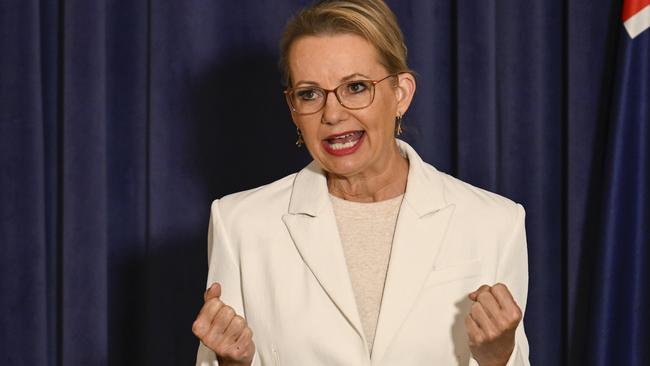
Yet it has never been more important for the Liberals and Nationals to present a united stance on energy policy. Australia needs a compelling alternative to the diabolic energy trajectory under Labor: we need policy that focuses on abundance, advancing Australia’s economic advantage, and sets us up for a future in hi-tech manufacturing, artificial intelligence and regional development.
A path forward can make clear that nuclear should never be banned, while acknowledging government-directed investment in nuclear is not aligned with sound market-based roots. Whether the Liberals pay lip service to a 2050 net-zero target (that won’t be met anyway) shouldn’t become an all-consuming issue that leaves the opposition abdicating from the public energy debate on what to do in the next 10 years when it really matters. Without a compelling energy policy alternative from the Liberals and Nationals, Australia will be left with an emboldened Labor to continue down the path of ideological and economically damaging environmental targets under the undue influence of radical activists.
Already, Labor’s fanciful green targets are being rendered impossible by the party’s contradictory environmental policies. It is leading to poor outcomes for our energy costs, energy reliability, jobs, taxes, environment and emissions.
The federal government is targeting 82 per cent renewables and 43 per cent emissions reduction by 2030. Victoria is targeting 95 per cent renewables by 2035. Most of these targets were set without regard to whether they were realistically deliverable. All these targets now appear impossible to achieve.
There are major economic, regulatory, logistic and reliability issues in delivering these targets, which cannot be addressed in time. Ironically, the biggest obstacles to the targets are Labor’s own environmental regulations; approvals to build anything, including renewables infrastructure and carbon credits, are becoming overly burdensome if not unworkable. Ambitious targets are laudable, but not when they become an unrealistic central point of planning and policy. This results in insufficient planning for the actual scenarios that eventuate when these targets are not met.
We are then caught scrambling for costly emergency fixes again and again: last-minute taxpayer-funded coal-fired power extensions, secret taxpayer-funded capacity investment (of ideologically driven higher-cost technologies), grid instability and manufacturing jobs losses.
Victoria targets 65 per cent renewables in 2030, increasing to 95 per cent in 2035, up from 40 per cent today. The 2030 target may be achieved. But to achieve the 2035 target Victoria needs to double its average annual renewables penetration growth rate of about 3 per cent across the past five years, towards 6 per cent for the five years to 2035. This is in defiance of the challenges that will make the next phase of renewables growth harder than the last phase.
As renewables penetration increases – especially beyond 70 per cent – wind and solar saturates, more storage and grid services are needed, and grid operability challenges become increasingly problematic. Seasonality challenges become harder, leaving the grid more dependent on gas capacity.
The recent Spanish blackout is illustrative, with Spain increasing gas generation to avoid a repeat. But Australia will struggle given our gas capacity is in decline after years of Labor policies that are hostile to gas, especially in Victoria. The federal 82 per cent renewable target suffers from the same problems as Victoria, at a compounded level. The big concern of the Australian Energy Market Operator and the industry is about system operability more than capacity these days. Transmission is key to addressing this. Merely building more wind farms won’t achieve much if they can’t reliably be connected to the grid.
Much more infrastructure, including transmission and interconnectors, is needed to enable haulage of new renewables supply and to maintain system reliability. But Labor’s push to toughen up the Environment Protection and Biodiversity Conservation Act may make it harder, if not unworkable, to get the approvals to roll out needed renewable infrastructure upgrades in time.
The Spanish blackout is a warning of things to come. It provides a lesson Labor refuses to learn for our own energy security. It is clear low inertia due to high renewables penetration was a key contributing factor to the blackout: it made the grid more vulnerable to a shock and made system recovery more difficult.
Even the renewables lobby argues the blackout signals more investment is needed in the grid. Perhaps these grid upgrades should occur before more renewables are added? This fiasco should sound familiar to Australians. Our grid is not ready to accommodate our renewable targets. The energy industry and government know the target won’t be met. The targets were based on how quickly Labor wanted to see coal’s demise, rather than a realistic timeframe to make the investments needed to replace coal. The problem is the government continues to plan based on this fairytale because acknowledging the targets won’t be met is too politically painful.
The result is we risk not having a backup plan when the inevitable renewables shortfall arrives. We are about to learn we cannot shut down coal, reduce investment in gas and stop investment in renewable infrastructure all at the same time. Somewhere, there will need to be an environmental and social licence trade-off made.
Labor’s 43 per cent emissions reduction target by 2030 will necessarily also fail. This is due in part to regulations slowing the renewables rollout. But mostly it is because the federal government is slowing down the generation of carbon offsets needed. Because of uninformed pressure from activists, key methods for carbon credits have been halted, with replacement methods under development continually delayed.
Our carbon market has become the biggest driver of conservation of Australian biodiversity and habitat during the past decade, along with returning more money to farmers across the nation. Yet green activists attack it just because the fossil fuel industry is one participant in the market.
Indeed, we have reached the incredible point where green activists are effectively campaigning against planting trees. And Labor is allowing these activists to influence policy. Australia is pursuing a delusional mix of policies that will result in economic and environmental decline: reduce coal and gas investment while also making it harder to build the needed grid infrastructure to roll out renewables, alongside making it harder to generate carbon offsets to keep manufacturing going amid rising safeguard mechanism obligations.
The economic damage from the Spanish blackout is still to be assessed. The more deeply personal suffering that results from major blackouts may not make headlines: the demise of family business stocks in cold storage; the elderly at risk on life support systems; couples who may no longer be able to have families after IVF clinics lose power; the loss of manufacturing jobs and the communities they support.
This is not the kind of pain any Australian should have to feel before we realise a practical path cannot be compromised to pander to a green fairytale. The Liberals and Nationals have the opportunity and duty to offer this practical energy policy trajectory.
Saul Kavonic is head of energy research at MST Marquee.




Energy and climate policy has finally ripped the Coalition in two. It appears the Nationals’ stance on support for nuclear and against a 2050 net-zero target has left an unreconcilable schism with the Liberal Party under Sussan Ley’s leadership, at least for now.